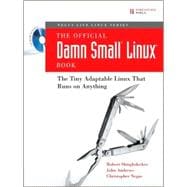
Robert Shingledecker’s IT career spans 35 years, beginning with hand-coding machine language programs targeted for Burroughs Corporation minicomputers. Later, he enjoyed using an assembler and then COBOL. Always having a passion for computers, he was an advocate for COMAL, and was an early hacker on MINIX and Coherent OS. In regards to Linux projects, Robert led the first large-scale deployment of Linux in the city of Garden Grove, California, where in 1994 he deployed Samba on DG/UX systems. He also designed a massively scalable Linux/AOLserver/Sybase e-commerce system. Robert then became CTO of several Linux-based dot-com companies. While building Linux-based, no install, live CD-ROM appliances, including firewalls, VPN, web, email, and database appliances, he became interested in Damn Small Linux. Soon, Robert joined John Andrews to help lead Damn Small Linux development. Now retired, Robert spends his time writing code and working on Damn Small Linux. He also enjoys traveling.
John Andrews is the creator of Damn Small Linux (DSL). As owner of a bead and jewelry store in 1996, John learned HTML and Perl to develop his own website. It eventually broadened to running websites for others on Linux servers. His interest in Linux encouraged him to switch to a Linux desktop full time. The appeal of fast and efficient applications led John to develop Damn Small Linux. After trying several mini-distributions, primarily for diagnostic and system recovery, John wanted to build a sub-50MB distribution that essentially had what he needed to accomplish a day’s work; the result was the Damn Small Linux distribution. John’s proficiencies include Perl, shell scripting, Lua, awk, *SQL, php, and some C programming languages.
Christopher Negus has been one of the world’s leading writers of Linux books for nearly a decade. His Red Hat Linux Bible series has sold more than one-quarter million copies worldwide. Chris also authored or coauthored the books Linux Bible (2005 through 2007 editions), Linux Toys, Linux Toys II, and Linux Troubleshooting Bible for Wiley Publishing. For Prentice Hall, Chris is the editor of the Negus Live Linux Series and author of that series’ flagship book, Live Linux CDs. Before becoming a full-time author, Chris Negus worked on UNIX operating system development teams at AT&T Bell Labs, UNIX System Labs, and Novell in the 1980s and 1990s. In particular, Chris worked in the areas of UNIX system administration and networking. When not working on computer books, Chris likes to spend time with his family: Sheree, Seth, and Caleb. Chris also enjoys playing soccer, singing opera (when nobody can hear him), and making things out of old computers.
| Introduction | |
| Using Damn Small Linux | |
| Overview of Damn Small Linux | |
| Booting DSL | |
| Using DSL Applications | |
| Configuring and Saving DSL Settings | |
| Extending Applications with MyDSL | |
| DSL Beyond the Live CD | |
| Running a Native Pen Drive Install | |
| Running DSL Embedded in Windows | |
| Installing DSL in Alternate Ways | |
| Performing a Traditional Hard Drive Install | |
| Creating Extensions and Remastering | |
| Adding Applications and Creating Shareable Extensions | |
| Setting Up a Full Remastering Environment | |
| Making Damn Small Linux Projects | |
| Running DSL on Alternate Hardware | |
| Making an Edna Music Server in DSL | |
| Using Skype VOIP Service in DSL | |
| Running a digital picture frame in DSL | |
| Setting up an XAMPP Web Server in DSL | |
| Table of Contents provided by Publisher. All Rights Reserved. |
The New copy of this book will include any supplemental materials advertised. Please check the title of the book to determine if it should include any access cards, study guides, lab manuals, CDs, etc.
The Used, Rental and eBook copies of this book are not guaranteed to include any supplemental materials. Typically, only the book itself is included. This is true even if the title states it includes any access cards, study guides, lab manuals, CDs, etc.